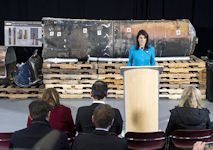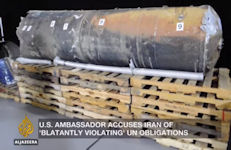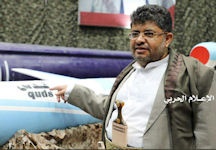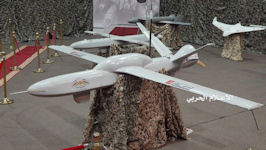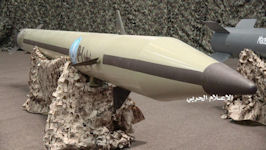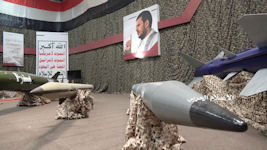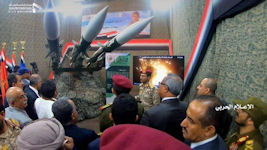Yemen / Houthi Missiles
On 15 December 2017, the US Ambassador to the UN displayed 'undeniable' evidence of an Iranian missile fired at Saudi Arabia by fighters in Yemen. Nikki Haley said the missile parts point to Iran's violation of an international arms agreement. Iran said the allegations were 'unfounded, irresponsible and provocative'.
Iran's foreign minister compared Haley's presentation with another by former US Secretary of State Colin Powell. This speech at the UN Security Council in 2003 about Iraq's weapons of mass destruction turned out to be false. Haley said the White House planned to rally international support to crack down on Iran.
The Houthis operate a variety of short-range tactical ballistic missiles, including the Soviet designed Scud-B [North Korean Hwasong 5], the Soviet Tochk. Houthi forces have used Soviet SA-2 SAM missiles as surface-to-surface weapons, calling the "new" missile “Qaher-1.” The Houthis acquired Iranian Zelzal-3 missiles which they have fired into Saudi Arabia.
The Houthis appear to operate at least three variants of the Scud, under the Burkan (Volcano) nomenclature. The ballistic missiles the Houthis had used by the end of 2017 included the Burkan 1, Burkan 2, and Burkan 2H. The Burkan 1 was very similar to an Iranian Shahab 1 or 2 and the North Korean Hwasong-5, which are Scud-B knock offs. The Burkan-2 was distinguished by a new "shuttlecock" payload section, as opposed to the simple conic warhead of the Burkan-1. The Burkan 2 was claimed to have a longer range, up to 1,000km. The Burkan-2H retained the "shuttlecock" payload section, but also deleted the tail fins seen on the earlier variants. The Burkan 2H appears to be an Iranian Qiam. The latest version had “significant design differences” from the Scud C and Hwasong-6 missiles, which are fashioned with heavy steel exterior that slows its trajectory. In contrast, the Houthi Borkhan H-2H was made with a lighter aluminum skin and a more advanced guidance system that negated the need for tail fins used on other Scuds.
There was no indication that the Houthis have acquired the longer range Shahab-3, with a range of 1400 km.
Ambassador Nikki Haley, U.S. Permanent Representative to the United Nations, on December 14, 2017 gave a briefing at Joint Base Anacostia-Bolling in Washington in front of the recovered pieces of a missile fired by Houthi militants from Yemen into Saudi Arabia. The missile’s intended target was the civilian airport in Riyadh, through which tens of thousands of passengers travel each day. She said " It was missing the large stabilizer fins that are typically present on these kinds of missiles. The Iranian Qiam missile was the only known short range ballistic missile in the world that lacks such stabilizer fins and includes nine valves that you will see running along the length of the missile. Those valves are essentially Iranian missile fingerprints. On your walk through, you will also see missile debris stamped with the logo of Shahid Bagheri Industries, an Iranian manufacturer."
The Kingdom of Saudi Arabia welcomed the report of the United Nations, which stressed that Iran’s hostile interventions and support for the Houthi terrorist militias with advanced and dangerous missile capabilities threaten the security and stability of the Kingdom and the region, reported the Saudi Press Agency (SPA). The Kingdom also welcomed the American position announced by the United States Ambassador to the United Nations, Nikki Haley, and its condemnation of Iran’s hostile activities in supporting and arming terrorist groups, including Hezbollah and the Houthi terrorist organizations.
The Kingdom of Saudi Arabia charged that Iran’s actions constituted a flagrant violation of Security Council resolution 2216 [14 April 2015] and Security Council resolution 2231, which has disrupted the political process and prolonged the crisis in Yemen. This resolution imposed sanctions, including a general assets freeze, travel ban and arms embargo, on Abdulmalik al-Houthi, who it called the Houthi leader, and Ahmed Ali Abdullah Saleh, son of the president who stepped down in 2011.
The Security Council in paragraph "14. Decides that all Member States shall immediately take the necessary measures to prevent the direct or indirect supply, sale or transfer .... from or through their territories or by their nationals, or using their flag vessels or aircraft, of arms and related materiel of all types, including weapons and ammunition, military vehicles and equipment, paramilitary equipment, and spare parts for the aforementioned, and technical assistance, training, financial or other assistance, related to military activities or the provision, maintenance or use of any arms and related materiel, including the provision of armed mercenary personnel whether or not originating in their territories..."
Saudi Arabia also condemned the Iranian regime for violations of other international resolutions, including Security Council resolutions 1559 and 1701, which prohibit supplying weapons to any extra-state militias in Lebanon (under Chapter VII), as well as Security Council resolutions 2231 and 2216.
Iranian Ambassador to Britain, Hamid Baeidinejad, said 15 December 2017 that while Nikki Haley was staging a fake show against Iran, Saudi Arabia was killing Yemeni people with American weapons. “Nevertheless, the few pieces of technical evidence that were merely talked about by her were not enough to prove that the rocket belonged to Iran,” he continued. The official stressed that even in the case of proving that the missiles were Iranian, she had to prove two other things; “one being that the missile had been fired from Yemen to Saudi Arabia and not brought from elsewhere to Washington.... Secondly, it needs to be attested that Iran had secretly transferred the missile to Yemen only after adoption of the Security Council sanctions resolution against Yemen and not before.”
“Furthermore, Haley had to provide compelling reasons why, given that Yemen was under the most severe international sanctions in sea, air and land, Iran has managed to move a large number of these missiles there,” underlined the official.
Iran noted that " at the time of the outbreak of the war in Yemen in 2015, the country had an estimated 300 SCUDs. Some of these munitions, reportedly modified by Yemeni engineers, have been fired at Saudi Arabia in retaliation for the countless air strikes over the past two years. .... the UN panel tasked with investigating Saudi and US claims of Iranian missile transfers to Yemen has neither found evidence of such supposed deliveries nor proof of foreign assistance with the use of such weapons. On the contrary, the panel has established that exclusively Yemeni experts fired the missiles in question, and that no missile components are likely to have been smuggled into the country via the Red Sea - directly contradicting the Saudi rationale for blockading Yemen. Curiously, the UN panel has reportedly found both US and Iranian components in the said missile fragments. On the basis of the logic presented by Saudi Arabia and the Trump administration, both the United States and Iran are thus apparently aiding Yemenis in their missile development."
Tehran denied arming Iranian-allied Shiite Houthis against the Saudi-led coalition which seeks to restore President Abd Rabbu Mansour Hadi, who was ousted by Houthis in September 2014. The chief commander of Iran's Islamic Revolution Guards Corps (IRGC) said in November 2017 that the Islamic republic provides "advisory assistance" for Yemeni Houthi militants.
The types of missiles employed by the Houthis and their ranges are a bit of a puzzle. The Shahab-2, based on the Scud-C, has a range of about 500 km with a 720-kg warhead. Iran had developed a Shahab-2 variant in 2010 to create the finless Qiam missile, which was estimated to have a range of at least 800 km with a detachable warhead. These range estimates are appreciably less than the ranges attributed to counterpart Houthi missiles. The Houthi-affiliated Al-Masira TV reported 03 September 2016 the Burkan-1 (Volcano-1) ballistic missile, an upgraded SCUD, had a range of over 800 km.
The range from Sa'dah [16°58'N 44°43'E], the capital city of Saada Governorate in north-western Yemen, was probably more like 700 km to Jeddah, and 900 km to Riyadh. The distance to these targets from the Al Wadeeh border crossing [16.94N 47.01E] was about 900km. The range from Sanaa to Riyadh or from Sanaa to Jeddah was equal to about 1,000 km.
Saudi Arabia and its allies have been at war in Yemen since March 2015, when the oil-rich kingdom intervened to push back the Houthis - who control the Yemeni capital, Sanaa - and reinstate the government of President Abd-Rabbu Mansour Hadi. The Houthis inflicted a drizzle of missiles on Saudi Arabia since then, but only began firing the longer range Burkan-2H / Qiam-1 in late 2017. Although superficially similar to the Burkan-1 and Burkan-2, the Burkan-2H was of entirely different construction [eg, aluminum rather than steel construction], and cannot be the product of a modification of these earlier designs.
The Burkan-2H / Qiam-1 design appears to be exclusive to Iran, and does not appear to have a North Korean counterpart. Prior to the civil war, the DPRK was the source of Yemen's missiles. There was no apparent reason for the Houthis to have withheld the Burkan-2H for over two years, if this missile was already in Yemen's inventory at the start of the civil war. A more plausible story line was that Iran managed to transfer these missiles to the Houthis when Yemen's legacy inventory of shorter range missiles proved unable to reach strategic targets in Saudi Arabia, such as Jeddah or Riyadh.
The Qiam-1 missile was first paraded in Tehran in 2010. At that time, Iran-Yemen relations were rather testy, as Yemen's government offered public and widespread allegations of direct Iranian support for the Houthi rebels. On 15 November 2009, Iranian Foreign Minister Manuchehr Mottaki told Al-Jazeera that Iran harbored no ill will towards Yemen and hoped to offer mediation services in the civil war. Offers by Iran to mediate between the Yemen's government and the Houthis in the Sa'ada conflict did nothing to assure Yemen of Iran's good intentions. Any hint that the government of Iran has influence with the Houthis has actually helped to further convince Yemen that Iran had ties to the Houthi rebels and aims to interfere in Yemen's internal affairs.
At that time, Yemen was quite persistent with allegations of Iranian infiltration, assistance to the Houthis, and destabilization of Yemen. Under these circumstances, it was implausible that Iran would have sold the Qiam-1 to the government of Yemen after 2010, or prior to 2015, when the UN arms embargo was enacted. The Iranian claim that "it needs to be attested that Iran had secretly transferred the missile to Yemen only after adoption of the Security Council sanctions" was spurious, as any such evidence would have been actionable intelligence that would have prompted an interdiction of such a shipment. The best available evidence was the flaming datum of the missile launch.


Missile Capabilities
| Model [ Houthi ] |
Model [ source ] |
Type | Propulsion | Launch | Warhead Mass |
Range (Km) |
Source Country |
| NONE | Shahab-3 | MRBM | Liquid | TEL | 600 | 1400 | Iran |
| Burkan-2H | ER Scud-C (Qiam-1) | MRBM | Liquid | TEL | 500 | 1000 | Iran |
| Burkan-2 | Scud-C (Shahab-2) | MRBM | Liquid | TEL | 500 | 900 | Iran |
| Burkan-1 | Scud-C (Shahab-2) | MRBM | Liquid | TEL | 500 | 800 | Iran |
| Scud-B (Hwasong-5) | SRBM | Liquid | TEL | 1000 | 300 | DPRK | |
| Zelzal-3 | SRBM | Solid | TEL | 600 | 200 | Iran | |
| Qaher-1 / Qaher-2M | SA-2 (S-75) / DF-7/CSS-8 | SRBM | Solid/Liquid | static | 500 | 180 | Iran / DPRK |
| Al-Mandab-1 | C-802 (CSS-N-8 Saccade) | ASCM | jet | static | 165 | 180 | Iran |
| SS-21 Tochka (KN-02) | SRBM | Solid | TEL | 482 | 70 | DPRK | |
| These are best available estimates, with considerable uncertainty on most particulars | |||||||
|---|---|---|---|---|---|---|---|
On 07 July 2019 the Houthi forces released several teaser photos of their new cruise missile and spy drones. Dubbed the “Quds”, the new Houthi cruise missile was expected to give the group a more sophisticated missile arsenal to challenge the Saudi Coalition. In addition to their cruise missile, the Houthi forces also unveiled two new spy drones that are dubbed “Sammad-1” and Sammad-3.
The head of the Supreme Political Council - Supreme Commander of the Armed Forces Field Marshal Mehdi Mashat - opened the exhibition of Martyr Saleh Al-Samad for the Yemeni military industries, which includes models of ballistic missiles, wings and new drones. During the opening of the exhibition The Marshal Mashat unveiling the new Yemeni weapons , a holy one winged missile and aircraft Smad 3 drone and aircraft Smad 1 drone reconnaissance aircraft roaring 2 K drone. The Supreme Commander of the Armed Forces, accompanied by pavilions of the exhibition and briefed on the contents of the models of the ballistic missiles of the system of Volcano 2 and medium range missiles, Qader and Badr.
The President of the Ministry of Defense, the Chief of the General Staff and the Spokesman of the Armed Forces, briefed the delegation on the tactical and combat characteristics of the new Mets and the Qods 1 missile and the stages of its manufacture. These new weapons will enhance the Yemeni military capabilities and change the course and course of the battle with aggression as weapons Effective and important deterrence.
Mashir Al Mashat and senior state leaders witnessed a documentary film about the Qods 1 missile and the new marshaled aircraft that reviewed their characteristics, characteristics and manufacturing stages, and live scenes of the testing of new weapons on multiple targets and the accuracy of their targets. He praised the qualitative achievements and successive successes achieved by the Yemeni armed forces in various aspects, including the areas of military manufacturing, which has achieved tangible successes, noting that the achievements of the missile force and flying aircraft was a boon to all Yemenis.
He stressed that the next stage will be full of surprises and that the new weapons will make a difference in the balance of power with the aggression and will change with it all the data for the benefit of our forces as these new weapons weapons of deterrence effective and influential.
For his part, the Minister of Defense said that the armed forces reached an advanced stage in the fields of military industries, which are witnessing every day a significant development and success in the hands and experiences of Yemen, pointing out that these weapons have been tested several successful operations and proved their ability and accuracy to hit their targets. The Minister of Defense that the next will be the greatest and most painful to the forces of aggression unless they make peace and stop their aggression and siege on the Yemeni people.
The Spokesman further noted that all details, characteristics and features of the new weapons and their testing will be announced at a press conference later. Attending the opening of the Martyr Saleh Al-Samad Exhibition for Yemeni Military Industries, member of the Supreme Political Council Mohammad Ali Al-Houthi, Speaker of the House of Representatives Yahya Al-Ra'i, Prime Minister Dr. Abdul Aziz bin Habtoor, Deputy Prime Minister for Defense and Security Affairs Major General Jalal Al-Ruwaishan, Defense Minister Major General Mohammad Nasser Al-Emati and Chairman of the General Staff General Mohammed Al-Ghamari and Director of Moral Guidance Department.
The military manufacturing unit, together with the Yemeni missile force, formed the main pillars in the battle of steadfastness and confrontation with the aggression for the fifth year in a row and were able, thanks to God, to rise to advanced and sudden levels of military industrialization, overcoming all the challenges imposed by aggression and siege. Manufacturing of missiles, aircraft and appropriate weapons required by the nature and specificity of the battle. The military industries were not limited to long-range ballistic missiles, drones and air defense. The development of these industries continued to include artillery, snipers and specialized missiles in the maritime field. Popular at all levels and levels.
The military surprises of Yemen with the expansion of military industries to the use of technology and modern technology in the manufacture of UAVs. This technique was the latest in the field of military manufacturing to carry out the combat and reconnaissance purposes of the attack, the monitoring of targets, the determination of enemy coordinates, direct monitoring of its targets and the battlefield, the determination of the coordinates of its assemblies and the control and correction of fire and artillery fire. The aircraft system includes multiple squadrons with different names and specifications.
The weakness of Saudi Arabia in manufacturing, on the one hand, and the direct confrontation on the other, lies in the absence of the military doctrine and the combat culture of their employees, the incompetence of the leadership and the army personnel who have not fought a war before. They lack the simplest experience, their motivation was absent.
Yemen’s Houthi militia unveiled four new surface-to-air missile systems described as potential ‘game changers’ in their half-decade-old war with the Saudi-led coalition, the pro-Houthi al-Masirah television channel reported in February 2020. In a ceremony inaugurating the systems in Sana’a, Houthi Supreme Political Council President Mahdi al-Mashat said the SAMs included the Fater-1 (‘Innovator-1’), and the Thaqib (‘Piercer’) line including the Thaqib-1, Thaqib-2 and Thaqib-3. “The new defence systems will change the course of the battle with US-Saudi aggression, and will provide a start to more sophisticated and effective defence systems in countering enemy air targets,” al-Mashat was quoted as saying.
The systems, said to have been “developed with purely Yemeni expertise,” were reported to have completed testing and entered into service. No further information was made available regarding their characteristics. Houthi defence minister Maj. Gen. Mohammed Nasser al-Atefi boasted that the missiles’ deployment would help make it possible to halt 'enemy' air operations over Yemeni territory. According to reports, the missiles were reverse-engineered from Soviet designs inherited from the People’s Democratic Republic of Yemen, or South Yemen. The Houthis’ use of old Soviet-era equipment has been widely reported, as has the transfer of missiles from Iran to the Houthis, which seems the likely source of these missiles.
On 22 February 2020, Houthi media reported that a Fater-1 missile was launched against a Saudi-coalition jet fighter, forcing it to flee Yemeni airspace. The coalition confirmed that a Saudi Royal Air Force Tornado strike fighter-bomber had been destroyed over northern Yemen, with Houthi media posting footage of the plane being shot down by a SAM.
In general, the Houthis are rapidly updating the range of their missile arsenal. For example, in 2015, the Houthis announced the release of the “Qaher-1” and “Qaher-M2” missiles, which join a family of Soviet surface-to-air missiles of the “SAM” type. In 755" modified for ground attack missions, these missiles can reach a range of 250-400 km.
As for the “Burkan 1” missiles, they were announced in 2016, and it was likely that it was a modified version of the Iranian “Shahab-1” missile with a range of up to 800 kilometers, followed by the “Burkan 2H”, which was revealed in 2017, which was a short-range ballistic missile derived from a missile. The Iranian “Qiam” has a range of 1,000 kilometers, and in September 2023, another derivative of the Iranian “Qiam” missile, which also has a range of 1,000 kilometers, was displayed, which was called “Aqeel.”
Since 2019, the Houthis have announced that they possess 4 “Burkan 3” missiles. The missile was the longest range in the Houthi arsenal (before the appearance of “Flood”), crossing the 1,200 kilometer barrier, and it was believed that it was used for the first time on August 1, 2019, when the Houthis claimed to use it to strike a military site . Saudi in Dammam, located on the eastern coast of the country, about 1,200 kilometers from the areas controlled by the Houthis in Yemen.
The Houthis’ arsenal of new drones, whose uses vary from monitoring and reconnaissance to combat, strikes, and performing suicide missions, such as the “Sammad” drones of all kinds, which are similar to the Iranian “Shahed” drones, and their range varies between 1,200 kilometers and 1,700 kilometers. The Houthis are believed to have used this drone in their August 2019 attack on the Shaybah oil field in Saudi Arabia, and they also announced its use in an attack denied by the Emirati authorities on Abu Dhabi International Airport in July 2018.
The Houthis also announced a “Weast” drone with a range of 2,500 kilometers. In particular, “Waid” resembles the Iranian “Shahed 136” drone, which was designed to attack ground targets from a long distance as a suicide drone that, once it reaches the target, explodes itself there. It was launched in batches of five or more drones to confuse air defenses by consuming their resources.
With a length of about three and a half metres, and a width of about two and a half metres, the Drone-5 was characterized by a wing in the shape of a short triangle, integrated into the central fuselage. The drone contains in its front a warhead estimated to weigh 30-50 kg, while the engine was located at the back of the drone’s fuselage and was driven by a propeller. Double-bladed pusher. The main role of this drone was to attack fixed ground targets, whose coordinates are known, and it was ineffective against moving targets.
In addition, the Houthi naval forces possess new tools, as in 2022 they displayed combat boats of the types “Asif”, “Mallah” and more recently “Nazir”, which have the ability to carry medium and light weapons and can fire 107 mm Katyusha rockets, which either They can be destructive or incendiary, and some of them can carry air defense systems, and are used to strike and control ships. In addition, the Houthis have self-driving boats for combat and maritime reconnaissance purposes. "Nadir" boats have the ability to carry medium and light weapons and can fire 107 mm Katyusha rockets, which are either destructive or incendiary (communication sites)
The Houthis also announced that they possess sea mines of the types "Masjoor", "Thaqib", "Karrar", "Mujahid" and others. Different types of sea mines are a self-contained explosive device placed in the water to damage or destroy surface ships or submarines. Mines are located at various depths in the water, and are activated when a ship was sensed. Each type has a specific depth and activation mechanism.
In addition, the Houthis possess Rubig 6 missiles, a Russian coastal defense system that uses KH-35UI anti-ship missiles, has a range of up to 260 kilometers, and operates using sea skimming technology, meaning it travels near the surface of the water to avoid radar. Each of them carries a 145-kg high-explosive warhead that was designed to penetrate barriers and compartments horizontally before detonating inside the ship.
The Houthi offer also included new versions of anti-ship guided missiles7, such as “Tankeel,” along with other types such as “Hatem,” “Faliq,” and “Sayyad,” which are winged missiles equipped with a radar or thermal seeker, with a total range of 200-400 kilometers. They all resemble Iranian missiles with the same specifications. The display also included “Quds 4” land-attack cruise missiles that can engage land and sea targets, and are part of the family of cruise missiles developed by Iran with a range of 800 kilometers.
The Houthis are developing their military arsenal, especially in two areas, namely missile range and maritime capabilities. It was certain that they now have the ability to reach the Israeli occupation state via missiles or suicide drones, in addition to their ability to target any ships passing off Yemen in the sea. the Red.
However, despite this, the Houthi missiles are not accurate enough, and despite their wide range, they can be intercepted with a degree of relative ease. However, this does not neutralize the Houthis’ threat to Israel or the United States, for two main reasons. The first was that their arsenal was developing rapidly, and the second was that it remains a great danger. Even with its current capabilities, it could exhaust many of the Israeli air defense resources, especially with the huge difference in the cost of manufacturing drones, for example, versus interceptor missiles. This opens a new, unexpected front in the south of the Arabian Peninsula, a long way from the center of the conflict in the occupied Palestinian territories.
The Yemeni Armed Forces (YAF) launched ballistic missiles at an Israeli military target in Eilat, occupied Umm al-Rashrash, in southern occupied Palestine, the spokesperson for the YAF, Brigadier General Yahya Saree, announced on 03 June 2024. Saree made the third announcement on the operations of the YAF in the past four days, saying that the YAF's Rocket Force attacked the site utilizing the "Palestine" ballistic missile. This was the first time that the YAF revealed its use of the weapon to attack long-range targets in occupied Palestine. The spokesperson stressed that the operation achieved its intended objective. Moreover, Saree reiterated that the YAF will continue to attack Israeli targets and Israeli-affiliated assets in support of the oppressed Palestinian people.
Yemen's Houthi militia kicked off a guerilla campaign of ship seizures, missile and drone attacks targeting 'Israeli-linked' merchant ships and the Israeli Red Sea port of Eilat in November 2023, vowing to continue their operations until Israel halts its operations in Gaza. The asymmetric conflict has seen several rounds of escalation.
The Houthis dramatically escalated their operations against Israel on 19 July 2024, flying a large, explosive-laden drone into downtown Tel Aviv and slamming it into a building 100 m from the US Consulate. The Houthis said the the attack was carried out by the Yafa, a mysterious new ultra long-range airplane-style drone with radar-evading capabilities. Yaffa also called Japho or Joppa in English, is an ancient Levantine port city now part of Tel Aviv-Yafo, Israel.
The Israeli military believed the drone used in the attack was an upgraded Samad-3 – a Houthi UAV that’s 2.8 m long, has a 4.5 m wingspan, a 1,500-1,800 km range and a 250 km/h top speed. However, given that the distance between Houthi-controlled areas of northern Yemen and Tel Aviv exceeds 2,000 km, the UAV used in the attack on Tel Aviv was likely either an upgrade to the Samad-series drone, or another model.
The Samad series consists of a whole lineup of spy and strike drones, including the Samad-1 – a surveillance UAV with a 3.5 m wingspan and 500 km range, and the Samad-4, a 3 m long strike drone with a 5 m wingspan, a 2,000 km+ range, and a 50 kg payload, which may include twin unguided bombs on hard points under its wings.
The Houthis also operate Qasef-1 and Qasef-2K kamikaze drones – simpler, low-cost, low-operational range UAVs believed to have taken design cues from the HESA Ababil and featuring a 30 kg warhead. Qasef series drones have a range of 150-200 km, a two hour flight endurance, and a three km flight ceiling. These drones have been used extensively by the militia to target US and British warships in the Red Sea in recent months. They’re complemented in the strike drone category by the Wa’aed, another Houthi loitering munition with looks outwardly similar to Iran's Shahed 136 (the latter was 3.5 m long, 2.5 m wingspan, 200 kg mass, 50 kg warhead and top speed up to 185 km/h).
The Houthis insist that their equipment was homegrown, and Iranian officials have also repeatedly emphasized that the Yemeni militia does not receive weapons from the Islamic Republic. That said, Iranian media have not denied the transfer of weapons technology to the Houthis, leaving it to the militia to build the armaments using domestic capabilities.
The militia rolled out the Khatif-1, a small, tele-guided strike drone with an estimated 10 kg payload and a range of a few dozen km, in 2021. An upgrade of that drone featuring an x-shaped tail instead of a ‘v’ pattern known as the Khatif-2 was spotted at a parade in 2022, but its characteristics are unknown.
The Houthis also operate the Mersad-1 and Mersad-2 series of surveillance drones – thought to be based on a reverse-engineered Boeing RQ-21s Blackjack –a 2.5 m long, 37 kg UAV with a 4.9 m wingspan, 93 km range and top speed of 170 km/h. The Houthi version's characteristics, including what sort of payload it can carry, remain shrouded in mystery.
Another reverse-engineered American UAV in the militia's arsenal was the Raqeep - a copy of the RQ-11 Raven. That tiny US drone was introduced into service with the US military in 2004, and exported to Yemen sometime before 2014-2015 Houthi-led revolution in Sanaa. The small, 0.91 m long, 1.9 kg drone has a 1.37 m wingspan, a 30 km/h cruising speed and 10 km range. It's powered by an electric motor. The Houthi version reportedly has a 15 km range and a 100 minute operational duration.
|
NEWSLETTER
|
| Join the GlobalSecurity.org mailing list |
|
|
|



